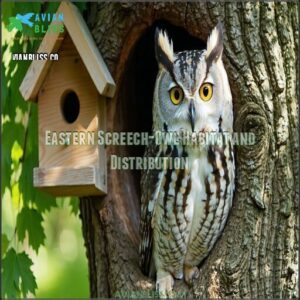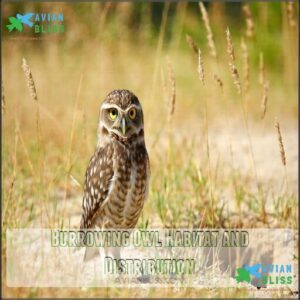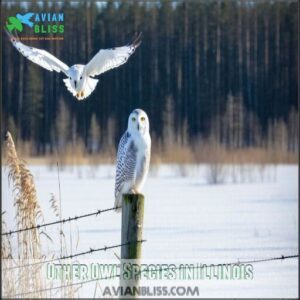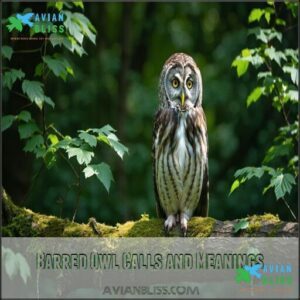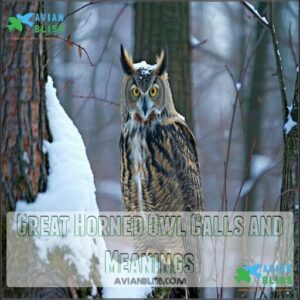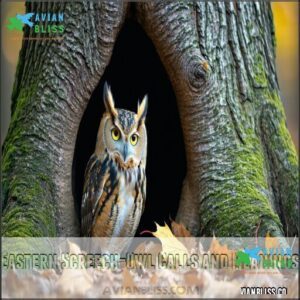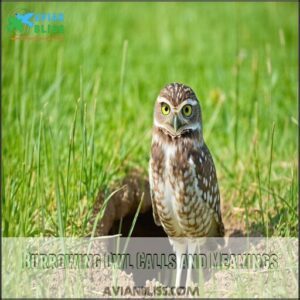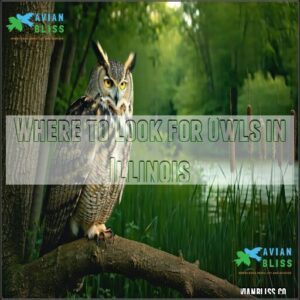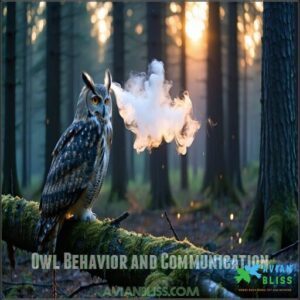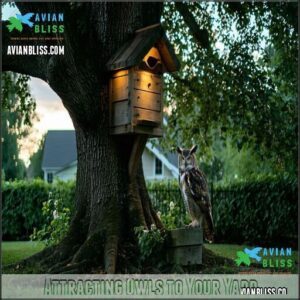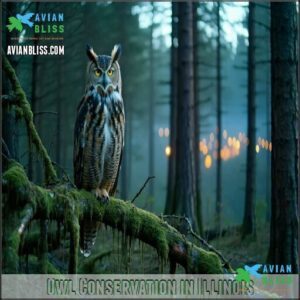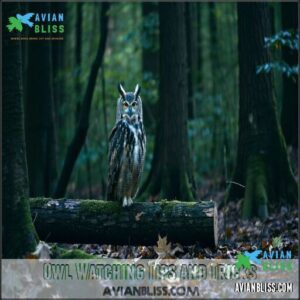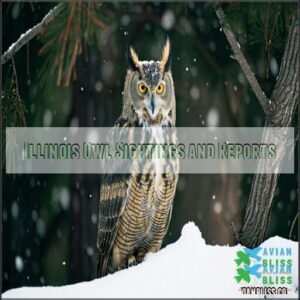This site is supported by our readers. We may earn a commission, at no cost to you, if you purchase through links.
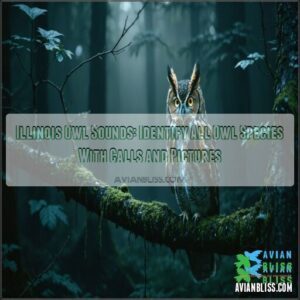
The Barred Owl’s call sounds like someone saying, “Who cooks for you?”, while the Great Horned Owl’s deep hoots are classic and powerful, like nature’s drumbeat.
Hear a soft, eerie trill? That’s probably the Eastern Screech-Owl, whispering secrets of the forest.
These nocturnal tunes help owls communicate, mark territory, and find mates.
With a little practice (and patience), you’ll be able to tell these species apart by sound alone.
Keep listening—there’s more to these voices than meets the ear, and it’s an experience that will leave you wanting to explore more of the natural world, and understand the secrets of the forest.
Table Of Contents
- Key Takeaways
- Illinois Owl Species
- Common Owl Sounds in Illinois
- Where to Look for Owls in Illinois
- Owl Call Identification
- Owl Behavior and Communication
- Attracting Owls to Your Yard
- Owl Conservation in Illinois
- Owl Watching Tips and Tricks
- Illinois Owl Sightings and Reports
- Frequently Asked Questions (FAQs)
- How many types of owls are there in Illinois?
- Are horned owls common in Illinois?
- Are owls in Illinois nocturnal?
- Are long eared owls hard to spot in Illinois?
- Where to see owls in Illinois?
- What do owls eat in Illinois?
- What is the most common owl in Illinois?
- What are some of the different noises owls make?
- What owl says hoo hoo hoo?
- Where can you see owls in Illinois?
- Conclusion
Key Takeaways
- Learn to identify owls in Illinois by their unique calls, like the Barred Owl’s “Who cooks for you?” or the Great Horned Owl’s booming hoots.
- Spot owls in habitats such as forest edges, wetlands, and grasslands, especially at dusk or dawn when they’re most active.
- Attract owls to your yard with nest boxes, native plants, and an insect-friendly environment, while avoiding bright lights and pesticides.
- Contribute to owl conservation by reporting sightings, reducing habitat destruction, and supporting local wildlife initiatives.
Illinois Owl Species
Illinois is home to a fascinating variety of owl species, ranging from the common Great Horned Owl to the striking Snowy Owl.
Illinois boasts diverse owls, from the classic Great Horned Owl to the striking winter guest, the Snowy Owl.
You’ll find these birds in diverse habitats across the state, each with unique calls and behaviors to explore.
Barred Owl Habitat and Distribution
Barred Owls can be found across Illinois, adapting to various habitats while favoring areas rich in resources.
Their distinctive "who cooks for you?" call echoes throughout several environments:
- Dense forests with sturdy canopies and ample tree cavities.
- Wetlands like swamps or riverbanks, offering plentiful prey.
- Woodland edges, perfect for hunting due to nearby open spaces.
- Urban parks, where mature trees provide nesting spots.
With a preference for undisturbed areas near water, these owls thrive in diverse Illinois wildlife settings.
Great Horned Owl Habitat and Distribution
Great Horned Owls are master adapters, thriving in Illinois’ diverse landscapes.
Their unmistakable "hoo-h’HOO-hoo-hoo" makes them stand out among owl sounds in Illinois.
These urban owls aren’t picky, flourishing in forests, wetlands, grasslands, and city parks.
Their adaptable habitats guarantee access to abundant prey, from rodents to birds.
Habitat Type Key Features Best Viewing Times
Eastern Screech-Owl Habitat and Distribution
Eastern Screech-Owls are fascinating year-round residents of Illinois, perfectly blending into tree bark with their mottled feathers.
These small owls thrive in diverse habitats, displaying impressive cavity dependence for nesting.
You’re likely to spot them in:
- Urban habitats like parks or gardens where they adapt well to nest boxes.
- Mature forests with natural tree cavities, perfect for raising their young.
- Forest edges, where they hunt small prey at dusk.
Their haunting trills are unforgettable among Illinois owl sounds.
Burrowing Owl Habitat and Distribution
Burrowing Owls are rare treasures in Illinois, relying on grassland dependence and burrow availability for survival.
If you’re fortunate enough to see one, you’ll notice they’re unique among owl species—active in daylight with subtle "coo-cooo" sounds.
These small owls are found in:
- Grasslands with short plants, ideal for spotting predators.
- Areas where ground squirrels or prairie dogs leave vacant burrows.
- Wildlife corridors connecting fragmented habitats, essential for movement.
- Farmlands and pastures away from urban sprawl.
They often repurpose existing burrows for nesting.
Due to habitat loss and their Illinois rarity, conservation efforts remain essential to protect these fascinating owls.
Other Owl Species in Illinois
Illinois is home to some incredible visitors in the owl world, each adding its unique charm to the landscape.
The Snowy Owl, with its bright yellow eyes and snowy feathers, graces open fields, occasionally airports, during winter. The elusive Long-eared Owl hides in dense woodlands, its ear tufts blending seamlessly into the trees.
Illinois also sees the occasional Northern Hawk Owl or Boreal Owl during rare irruptions.
| Owl Species | Habitat | Fun Fact |
|---|---|---|
| Snowy Owl | Open fields, airports | Hunts lemmings in the Arctic tundra |
| Long-eared Owl | Dense woodlands | Known for owl calls during twilight |
| Northern Hawk Owl | Conifer forests, rare visits | Can hunt during daylight |
Common Owl Sounds in Illinois
You can identify many Illinois owls by their unique calls, from the haunting hoots of the Great Horned Owl to the melodic trills of the Eastern Screech-Owl.
Understanding these sounds helps you recognize each species and appreciate their roles in the local ecosystem.
Barred Owl Calls and Meanings
If you’ve ever roamed Illinois woodlands, you’ve likely heard the unforgettable “who-cooks-for-you, who-cooks-for-you-all” of a Barred Owl. Their calls aren’t just haunting hoots but a fascinating language of layered meanings.
Barred Owl vocalizations vary depending on purpose. During breeding season (January-March), males establish territories and woo mates with amplified calls. You might hear duets, blending up to 13 call types—an acoustic marvel! Females add their higher-pitched notes, creating uniquely identifiable “dialects.”
Ever heard a Barred Owl’s “monkey call”? This sound signals agitation—often heard when they’re annoyed or defending territory. Their calls, capable of traveling half a mile in thick forests, are surprisingly common during daylight.
- “Who-cooks-for-you”: Territory and communication.
- Monkey calls: Emotional outbursts.
- Daytime calls: Rare among owls.
- Contextual calls: Vary by situation—aggression, mating.
- Acoustic analysis: Tracks distinct vocal variations.
Great Horned Owl Calls and Meanings
The great horned owl has one of the most iconic owl calls in Illinois. Its booming pattern of 3-8 hoo sounds, like "hoo-h’HOO-hoo-hoo," echoes in forests.
During the mating rituals, males respond to females with deeper tones, forming duets. You’ll also hear their territorial defense calls—harsh barks or screeches—to warn intruders near nests.
As spring arrives, listen for the high-pitched chatter of fledglings, a form of owlet communication. These owl sounds are typically heard at dusk or dawn, making them perfect for nature lovers looking to identify owl calls in peaceful Illinois settings.
Similarly, herons also have unique vocalizations for communication. These wetlands are essential for heron habitats.
Eastern Screech-Owl Calls and Meanings
Eastern Screech-Owl vocalizations are nature’s soundtrack in suburban parks and wooded backyards.
Their eerie, descending whinny calls pair seamlessly with rhythmic trills, making them unmistakable. Screech-owls, known for their red or gray morphs, often nest in tree cavities within urban habitats.
Here’s how to recognize their owl calls:
- Territorial Calls: Deep tones from males as they claim space.
- Contact Calls: Soft, subtle sounds used for communication.
- Alarm Screeches: Sharp, high-pitched cries signaling danger.
- Trill Calls: Soothing, repetitive rhythms reassuring nearby owlets.
These unique Eastern Screech-Owl sounds captivate listeners.
Burrowing Owl Calls and Meanings
Burrowing Owls may be small, but their vocalizations sure grab attention. Their classic "coo-coooo, coo-coooo" often fades into a soft wheeze, making these owl calls distinct.
They’re the masters of sound, with alarm calls like hissing or buzzing, mimicking rattlesnakes to scare predators.
Inside the burrow, communication thrives. Juveniles use raspy chirps for food, while adults exchange soft, rhythmic sounds to stay connected.
These rare Illinois visitors even exhibit regional dialects, giving their calls a local flair.
- **Isn’t it fascinating?
** These clever owls prove you don’t need to hoot like others to be heard, highlighting the charm of Burrowing Owl vocal development.
Where to Look for Owls in Illinois
If you’re looking for owls in Illinois, focus on areas with dense trees, open fields, or wetlands.
These habitats provide shelter, hunting grounds, and nesting spots for a variety of owl species across the state.
Best Places to Spot Barred Owls
If you’re keen to spot a Barred Owl, head to Shawnee National Forest, where dense trees and wetland edges create ideal habitats.
Barred Owls favor areas near water sources and forest edges that double as perfect nesting sites.
Kickapoo State Park is another great spot—try dawn visits in autumn for the best chance.
During summer, explore the Illinois River Valley, listening for their signature “Who cooks for you?” call echoing through the woods.
Keep an eye out near tree cavities or along quiet riverbanks, where these masters of camouflage melt into the beauty of Illinois wildlife.
Best Places to Spot Great Horned Owls
You’ll find Great Horned Owls in Illinois’ Forest Preserves, Urban Habitats, and Wetland Areas, especially during seasonal changes like fall and spring.
Their loud, deep calls echo through diverse landscapes.
Familiar spots include:
- Shawnee National Forest – Ideal for nighttime listening.
- Starved Rock State Park – Explore trails at dusk.
- Grasslands with old hawk nests – Check for nesting sites.
- Wildlife Corridors – Walk quietly to hear owl sounds.
- City Parks – Spot owls in urban Illinois wildlife.
Best Places to Spot Eastern Screech-Owls
To spot an Eastern Screech-Owl in Illinois, focus on their preferred habitats and unique calls.
These adaptable owls thrive in urban habitats and forest edges.
Here’s where to find them:
- Explore tree cavities near forest edges or state parks.
- Visit heavily wooded urban parks with mature trees.
- Check nesting sites in your backyard, especially with nest boxes.
- Walk wooded trails at Shawnee National Forest.
- Use listening tips to identify Illinois owl sounds like trilling calls during spring evenings.
Best Places to Spot Burrowing Owls
From the earlier discussion about Eastern Screech-Owls, let’s shift focus to the elusive Burrowing Owl, one of the most unique Illinois owls to observe.
These small, long-legged owls thrive in suitable habitats like grasslands, prairies, and open fields where burrow availability is abundant.
Look for them in Shawnee National Forest or Prairie Ridge State Natural Area, especially in areas rich with abandoned burrows from prairie dogs or ground squirrels.
Their soft calls, resembling a gentle “coo,” often echo at dawn or dusk, revealing their presence.
- Keep an eye out for prime burrow entrances marked by small dirt mounds, especially early mornings.
Practice viewing etiquette, and appreciate these uncommon Illinois wildlife treasures!
Owl Call Identification
Learning to identify owl calls helps you recognize these elusive birds, even when they’re hidden from view.
Each species has its distinct sounds, from the Great Horned Owl’s deep hoots to the Barred Owl’s almost conversational hooting, which can be considered distinct sounds.
How to Identify Barred Owl Calls
When wandering through Illinois woodlands at sunset, you may hear the unmistakable call of the Barred Owl: “Who cooks for you? Who cooks for you-all?” It’s one of the most iconic sounds in the region and a clear example of Barred Owl Vocalizations.
These owl calls are loud, rhythmic, and often repeated to establish territory or communicate with mates. Barred Owls don’t just hoot—they produce cackling duets during pair bonding and sharp bill-snapping when defending their nests.
Occasionally, their eerie “laughs” echo through dense woodland—a sound often mistaken for something out of a ghost story.
To improve your chances of identifying owl calls, pay attention to habitat. Barred Owls thrive in Illinois’s swampy forests. Try mimicking their classic hoot—you might just have a curious owl respond back.
How to Identify Great Horned Owl Calls
The great horned owl’s haunting, distinctive hooting echoes in deep, gravelly tones, perfect for late-night mystery.
Their duet-like owl calls feature females taking the lead, males offering softer replies.
Pay attention to their steady rhythm and low, resonating pitch—like a foghorn in the woods.
- Tip: Territory calls are louder, especially during mating season.
Juvenile sounds, on the other hand, include softer screeches or faint begging cries.
How to Identify Eastern Screech-Owl Calls
Eastern Screech-Owl vocalizations are unmistakable. Their soft whinnies and soothing trills create a calming nighttime symphony, especially in wooded areas.
To identify them, follow these tips:
- Listen for Red/Gray morph differences: These owls blend into habitats, but their sounds stand out.
- Notice trilling vs. screech: Males trill steadily, while females often alternate with softer screeches.
- Understand call variations: A rapid whinny may shift into rhythmic trills, blending acoustics with nature.
- Use habitat acoustics: Forest edges amplify these Illinois owl sounds, showcasing unique owl vocalizations.
Take your time learning their enchanting calls—you’ll treasure the experience!
How to Identify Burrowing Owl Calls
Burrowing Owl calls add a unique twist to Illinois owl sounds, with their high-pitched “coo-coooo” standing out against the soft hum of grasslands.
These owl vocalizations are easiest to catch during dawn or dusk, their preferred active hours. A particularly fascinating feature is their ability to mimic a rattlesnake’s hiss, a trick that keeps predators at bay—a true survival genius of the owl world!
To identify their calls, focus on short, rhythmic bursts with a gravelly quality. Look for Habitat Clues like open fields or rodent burrows.
Unlike typical “hoot-sounding” owl calls, Burrowing Owls surprise with varied sounds, including clucks and rasps. These small, ground-dwelling owls might lack height, but their vocal patterns are unforgettable.
Owl Behavior and Communication
You can learn a lot about owls by observing how they communicate through their calls, body language, and behavior.
Owls speak volumes through their haunting calls and subtle gestures, revealing the secrets of the nighttime wilderness.
These fascinating birds use sounds and movements to claim territory, attract mates, and respond to threats or intruders, which is a crucial aspect of their behavior.
Why Owls Make Different Sounds
Owl vocalizations are an incredible example of nature’s communication methods.
Every hoot, screech, or trill you hear from Illinois owls holds a purpose, from calling a mate to defending territory or warning of danger.
These sound variations are finely tuned, influenced by environmental factors like wind or distance, ensuring their messages carry through the night.
Notably, some owls even develop individual dialects, giving their calls a unique twist—like their own signature tune.
Next time you encounter Illinois owl sounds echoing through the dark, remember it’s not random noise, but a well-designed system keeping these fascinating creatures connected and thriving, using nature’s communication methods in a unique way to convey their messages.
How Owls Use Body Language
Owls talk with their bodies, not just through owl sounds or vocalizations.
Wing signals clue you in—a wide spread shows confidence, while tucked wings mean unease.
Feather positions like a puffed chest signal display, and ruffled feathers suggest agitation.
Watch facial expressions closely; a sharp stare feels intimidating, while a head tilt shows curiosity.
Even their posture meanings matter—small foot twitches can hint at excitement.
Understanding these contextual cues reveals Illinois owl behavior and deepens your connection to owl communication.
This knowledge helps you better comprehend the importance of body language in their interactions.
Owl Mating and Breeding Habits
Owls truly impress with their courtship rituals, where males serenade mates with owl sounds, perform graceful flights, and offer food gifts. Most species form lifelong monogamous pairs, showing loyalty and teamwork.
During breeding, females carefully choose hidden spots like tree cavities or abandoned hawk nests to raise their young. Depending on the species, they’ll lay clutches of 1-12 eggs, beginning an incredible journey of fledgling care.
Here’s what makes their nesting habits unique:
- Both parents share responsibilities for incubating eggs and hunting.
- Many species return annually to the same nesting spots.
- Minimal effort goes into nest-building—reused structures are common.
- Young owls develop quickly, flying within weeks of hatching.
By understanding these behaviors and owl vocalizations, you’ll admire their intricate breeding cycles.
Attracting Owls to Your Yard
You can attract owls to your yard by creating a safe and welcoming habitat with natural cover and proper nesting spots.
Providing a food-rich environment, like areas with mice and insects, increases your chances of spotting these fascinating birds.
Creating an Owl-Friendly Environment
Creating an owl-friendly environment in your yard invites majestic Illinois owls, like Barred and Eastern Screech-Owls, to settle nearby.
These birds thrive in natural spaces that prioritize their needs—and it’s easier than you think to make a difference.
Focus on supporting their habitat with simple steps:
- Reduce pesticides: Healthy prey populations like insects and small mammals are key for owls.
- Leave old trees or snags: Deadwood provides nesting habitats and safe roosting spots.
- Add water sources: A small pond or birdbath supplies hydration and attracts prey like frogs.
- Limit lighting: Bright lights reduce the darkness owls rely on for hunting effectively.
- Protect prey and plant natives: Native shrubs or grasses draw rodents, creating a balanced owl habitat.
By transforming your yard into a welcoming space, as well as hearing enchanting owl sounds, you also contribute to Illinois wildlife and owl conservation.
Best Foods to Attract Owls
Forget the birdseed—owls don’t snack on seeds like their feathered friends. To attract them, think like nature would.
- Promote Rodent Populations: Let grass grow along the edges of your yard to create shelter for mice and voles, keeping an owl’s favorite prey nearby.
- Increase Insect Abundance: Plant flowers to draw crickets, beetles, and other protein-rich bugs owls hunt.
- Encourage Habitat Diversity: Add berry bushes or scatter nuts to bring in squirrels and other small mammals for their next meal.
Let the natural cycle work! You can buy owl attractants to further encourage owls.
How to Build an Owl Nesting Box
Building an owl nesting box is a great way to attract these fascinating birds to your yard while supporting owl conservation.
Start with Material Selection: use untreated pine or cedar, which is durable and safe for owl habitats. For Box Dimensions, include a 3-inch entrance hole and line the bottom with wood chips for a cozy interior.
In terms of Mounting Techniques, install the box 10-15 feet high on a sturdy tree away from busy areas. Consider purchasing a pre-made owl house for simpler installation.
Adding a predator guard around the base protects against unwanted visitors. Regular maintenance, like clearing debris each season, keeps the box inviting.
A well-placed nesting box enhances your backyard attraction and makes birdwatching even more rewarding, especially for Illinois’ local owl species.
Owl Conservation in Illinois
You can help protect Illinois’s owls by learning about the challenges they face, such as habitat loss and pollution.
Conservation efforts focus on preserving their habitats, monitoring populations, and promoting coexistence with these incredible birds, which is crucial for their survival and conservation.
Threats to Owl Populations
Understanding threats to Illinois owls can inspire meaningful action.
These stealthy hunters face growing challenges that impact their survival:
- Habitat Loss: Urban development shrinks forests and wetlands, leaving owls scrambling for safe homes.
- Climate Change: Warmer winters disrupt prey availability, nesting cycles, and overall owl population trends.
- Rodenticides: Poisoned prey weakens the food web, harming owl health and their conservation status.
- Collisions: Foraging near roads often ends tragically for these night flyers.
Protecting owl habitat and addressing prey scarcity are essential for safeguarding Illinois wildlife and ensuring healthy owl populations.
Conservation Efforts in Illinois
Illinois is making big strides in protecting owls through thoughtful owl conservation efforts.
Habitat preservation, reducing pesticides, and creating safe spaces like sanctuaries are helping these birds thrive.
For example, wildlife corridors connect fragmented landscapes, giving owls a safer way to hunt and nest.
Partnerships across the state contribute to Illinois conservation goals, supporting both ecological and economic objectives.
Satellite tracking has been essential in studying owl behavior and creating smarter habitat protection policies.
Owl conservation initiatives also focus on rehabilitation programs for injured birds and education initiatives to inspire communities to care for local wildlife.
| Effort | Goal | Example |
|---|---|---|
| Habitat Preservation | Protect nesting areas | Forest replanting |
| Rehabilitation | Aid injured owls | Wildlife centers |
| Education Initiatives | Raise public awareness | Youth workshops |
These owl conservation projects highlight Illinois’ dedication to preserving its native species.
How to Get Involved in Owl Conservation
Getting involved in owl conservation isn’t just about saving birds—it’s about preserving the harmony of nature.
You can make a real difference while enjoying the sights and sounds of Illinois owls. Simple steps at home or volunteering in the field both go a long way.
Here are some practical ways to pitch in:
- Participate in habitat restoration by planting native trees and shrubs, which provide shelter and food for owls.
- Engage in citizen science programs like eBird by recording owl sightings and contributing to essential research.
- Minimize pesticide use to protect the insects and small mammals that owls depend on for survival.
- Support owl conservation organizations, whether by donating funds, time, or expertise.
- Join education outreach efforts by mentoring or teaching others about owl sounds and behaviors.
You can also contribute by monitoring bird populations to track their diversity.
Each action brings us one step closer to ensuring Illinois’ beautiful owl calls echo for future generations.
Owl Watching Tips and Tricks
When you’re out watching owls, it’s all about patience, timing, and being prepared with the right gear.
Learning to move quietly and observe without causing alarm helps you catch incredible glimpses of these elusive birds in their natural habitat.
Best Time to Go Owl Watching
When’s the best time to get started with owl watching? It depends on seasonal variations and key factors like weather conditions and the lunar cycle.
Owls are most active at dawn and dusk, making these times ideal for listening for owls and spotting movement. In winter, clear nights amplify Illinois owl sounds as their vocalizations carry farther.
To improve your viewing experience, consider investing in specialized viewing equipment. Full moon phases help with visibility, blending light with sound for an immersive experience.
Here’s a quick guide:
| Season | Best Time | Why It Works |
|---|---|---|
| Winter | Dawn/Dusk | Amplifies owl calls |
| Migration Periods | Twilight | Increases activity |
| Full Moon Phases | Nighttime | Enhances visibility |
Best Equipment for Owl Watching
To make owl watching rewarding, gear up with items that help you explore nocturnal habitats.
Start with binoculars (8x or higher) for spotting owls perched on distant branches. An audio recorder captures unique owl sounds, helping with owl identification later. For low-light conditions, night vision goggles or a red-filtered headlamp protect your natural night vision while keeping your surroundings visible.
To carry everything comfortably, consider a sturdy backpack with multiple compartments.
Enhance your kit with:
- Camouflage gear: Blends with the environment for better owl watching.
- Field guides: Handy for identifying Illinois owl species.
- Spare batteries: Guarantee gadgets won’t fail during long hours of tracking.
To guarantee that all your equipment functions properly, it’s vital to check them before heading out.
How to Approach Owls Without Disturbing Them
Respecting Territory while observing owls requires patience and quiet observation.
To minimize impact on their behavior, follow these ethical birding practices:
- Move slowly – Imagine you’re tiptoeing on thin ice; sudden motions frighten owls.
- Stay quiet – Listen to Illinois owl sounds, like hoots or trills, instead of making noise yourself.
- Maintain distance – Keep at least 50 feet away to respect their space while enjoying natural owl behavior.
- Avoid flash – Use soft red lights for visibility during nighttime owl watching.
- Blend into your surroundings – Use trees and foliage as cover for stealthy observation.
These owl-watching techniques guarantee you enjoy their calls without disrupting them.
Illinois Owl Sightings and Reports
You can track owl sightings across Illinois to uncover patterns in their habitats and seasonal behaviors.
By reporting your own observations, you’ll contribute valuable data to local wildlife studies and help protect these fascinating birds.
How to Report Owl Sightings
When you spot an owl, take the chance to make an impact by sharing your observation through Reporting Platforms like eBird or iNaturalist.
These contribute to Citizen Science, helping researchers analyze owl data for conservation. Record details including the owl species, date, behavior, and exact location.
Upload any photos or recordings for ID Verification, whether it’s Illinois owl sounds or visual clues. This confirms accurate contributions.
Avoid approaching too closely—disturbing owls can harm them. Every report holds Conservation Impact, supporting efforts to track populations.
Your shared owl sightings—from snowy owls to screech-owls—give valuable insight into their habitats and presence across Illinois.
Owl Sightings by Region in Illinois
You’ve reported your findings—now let’s explore where Illinois owls roam.
Regional abundance varies with habitat differences, migration patterns, and population density.
Northern Illinois shines with Snowy Owls and their ghostly presence in open fields. Central hotspots feature Great Horned Owls, adapting to urban and rural areas year-round.
Southern Illinois offers a haven in Shawnee Forest for Northern Saw-whet Owls.
Highlights include:
- Snowy Owls gracing Chicago parks and Lake County beaches.
- Long-eared Owls hiding in dense woods like Lincoln Park.
- Screech-Owls calling near Eastern Illinois treelines.
- Western Illinois hosting winter Great Horned Owl sightings.
Frequently Asked Questions (FAQs)
How many types of owls are there in Illinois?
Imagine nature’s hidden orchestra—Illinois hosts ten owl species.
Seven are regulars, like the Great Horned or Snowy Owl, while four are rare gems, including the Barn and Northern Hawk Owls.
Each brings its own melody.
Are horned owls common in Illinois?
Yes, Great Horned Owls are common in Illinois.
They’re year-round residents, thriving in forests, urban parks, and open areas.
Their iconic hoots and adaptability make them one of Illinois’ most recognizable owl species.
Are owls in Illinois nocturnal?
Owls in Illinois are mostly nocturnal, like nature’s night shift workers.
They hunt and communicate under the moonlight, though some, like the Short-eared Owl, might showcase daytime activity in specific habitats.
Are long eared owls hard to spot in Illinois?
Long-eared Owls are notoriously tricky to spot in Illinois due to their excellent camouflage and preference for dense wooded areas.
They’re nocturnal and secretive, so patience and a sharp eye are essential to find them.
Where to see owls in Illinois?
Ten of North America’s nineteen owl species live in Illinois.
Head to forest edges, wetlands, or grasslands. Parks like Starved Rock offer prime spotting spots.
Listen at dusk or dawn for their distinctive calls!
What do owls eat in Illinois?
In Illinois, owls dine on a smorgasbord of prey.
They target small mammals like mice, voles, and rabbits, birds, insects, and even reptiles.
Some, like Great Horned Owls, hunt larger animals, including skunks and geese.
What is the most common owl in Illinois?
Like a reliable neighbor you always see around, the Great Horned Owl is Illinois’ most common owl.
It thrives year-round, adapting to forests, parks, and even urban areas, making it easy to spot.
What are some of the different noises owls make?
Owls make a variety of sounds: hoots for territory, screeches when alarmed, soft whistles during courtship, and trills to communicate with mates.
Each species has unique calls, like the Snowy Owl’s hoarse rhythm or Screech-Owl’s wails.
What owl says hoo hoo hoo?
You might hear a Great Horned Owl‘s deep, haunting "hoo-hoo-hoo" call, a sound that echoes through the night, signaling its presence with a distinctive, repetitive hooting pattern.
Where can you see owls in Illinois?
You can spot owls in Illinois at wooded parks, forest edges, wetlands, or grasslands.
Watch for Great Horned and Eastern Screech-Owls year-round, while Snowy and Long-eared Owls are winter highlights near open fields.
Conclusion
Exploring Illinois owl sounds opens a doorway to nature’s secret symphony, a soundscape you won’t forget.
By learning their distinct calls, like the Barred Owl’s “Who cooks for you?” or the soft thrills of the Eastern Screech-Owl, you’ll discover a new way to connect with wildlife.
Use these tips to identify calls, spot owls, or even attract them to your yard.
With patience and curiosity, you’ll deepen your understanding of these fascinating nocturnal creatures and keep listening to their secret symphony.
- https://dnr.illinois.gov/education/wildaboutpages/wildaboutbirds/wildaboutbirdsraptors/family---tytonidae/wabbarnowl.html
- https://www.inaturalist.org/guide_taxa/747701
- https://www.allaboutbirds.org/guide/Snowy_Owl/id
- https://allaboutbirds.org/
- https://www.nature.org/content/tnc/nature/us/en-us/about-us/where-we-work/united-states/illinois.html



